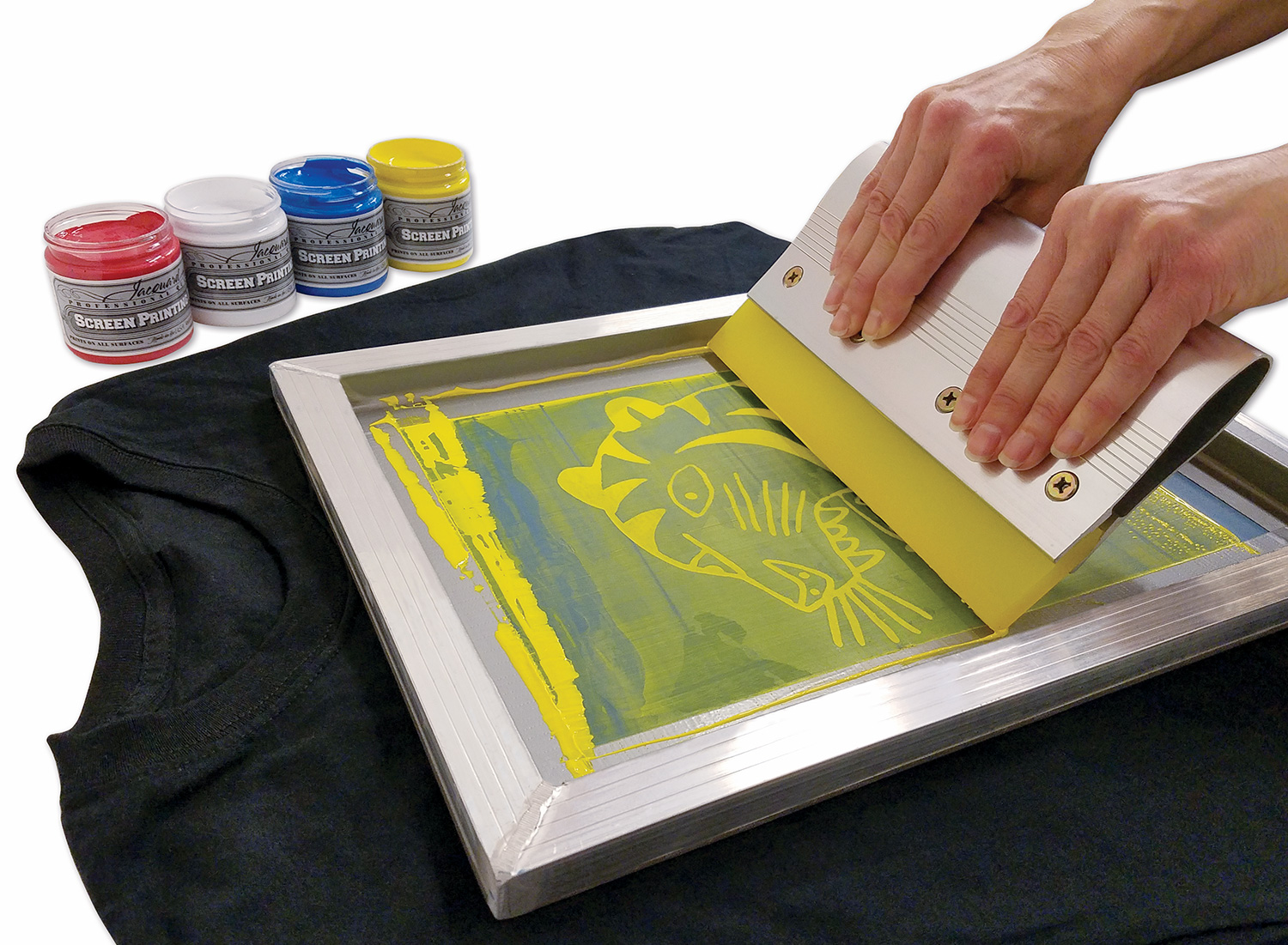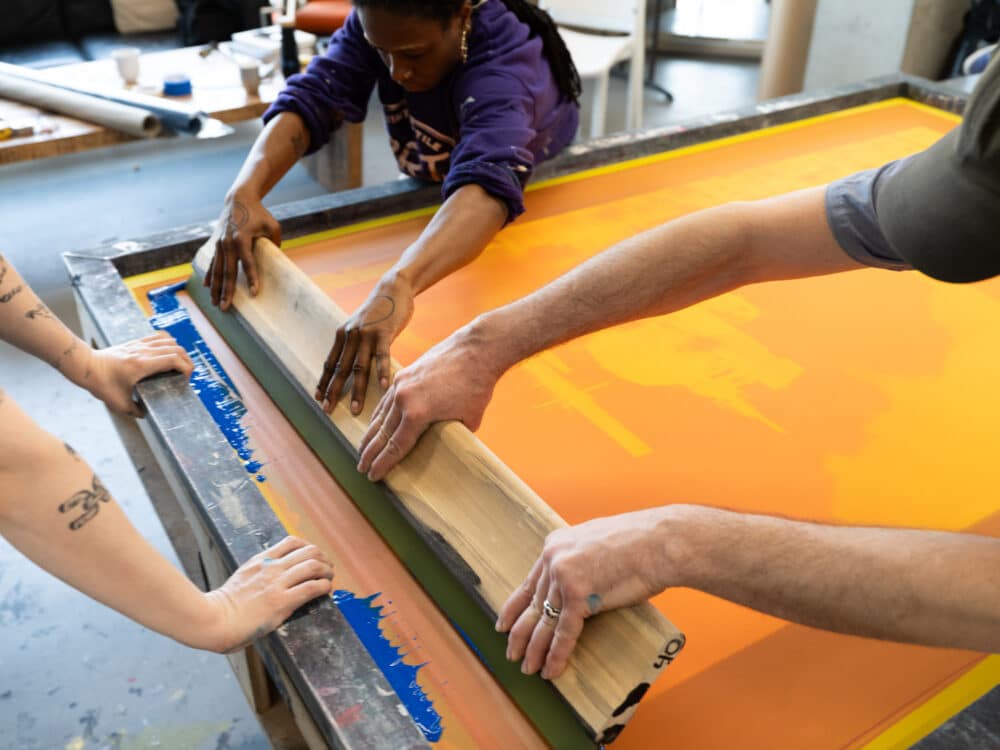ChatGPT said: Top insights to work with 10:9 Design Texas for promotional products
Discover the Numerous Types of Screen Printing Techniques for Your Next Job
Screen printing offers a varied variety of methods that can improve any type of imaginative project. From standard methods like serigraphy to contemporary advancements such as direct-to-garment printing, each strategy has its unique advantages. Specialty options, consisting of metal and environmentally friendly inks, introduce a lot more possibilities. Recognizing these techniques can significantly affect the final end result. The obstacle exists in choosing the most ideal method for specific demands and preferred impacts. What elements should one think about?

The Fundamentals of Screen Printing
Screen printing may appear complicated, it is basically a simple procedure that includes transferring ink with a mesh screen onto numerous surface areas. The method starts with the creation of a stencil, which defines the layout to be printed. This pattern is connected to a mesh screen, commonly constructed from polyester or nylon. Once the stencil is in place, ink is related to the screen and pushed via the mesh making use of a squeegee, resulting in the wanted pattern being printed on the underlying product.
Screen printing can be done on a variety of substrates, including material, plastic, and paper, making it a flexible choice for numerous tasks. The procedure permits for dynamic colors and detailed layouts, making it popular in sectors such as advertising, fashion, and art. Understanding these essentials outfits people with the fundamental understanding called for to explore advanced methods in screen printing.
Standard Screen Printing Techniques
Typical screen printing strategies have actually been used for centuries, maintaining the workmanship and creativity of this method. This strategy utilizes a mesh screen to transfer ink onto a substratum, such as textile or paper, enabling for durable and vibrant styles. The procedure begins with producing a stencil, which blocks certain locations of the screen to control where the ink will be used.
One preferred method is serigraphy, commonly used for restricted editions and imaginative prints. Another is making use of water-based inks, which are green and offer a soft feel on fabrics - 10:9 Design reviews. In addition, standard techniques can consist of manual printing, where artisans use ink with a squeegee, guaranteeing precision and focus to information
These techniques stay valued in the market for their tactile top quality and the one-of-a-kind structures they generate, attracting both consumers and developers who appreciate the heritage of screen printing.
Digital Screen Printing Innovations
As the need for faster manufacturing and modification in the printing industry has risen, digital screen printing developments have arised as a game-changer. This innovation mixes typical screen printing approaches with electronic processes, enabling quick prototyping and elaborate designs that were previously tough to attain. One considerable innovation is the introduction of direct-to-garment (DTG) printing, which assists in high-quality, full-color prints on different fabrics without the need for screens. In addition, improvements in ink formulas have actually brought about green choices that preserve lively colors while reducing ecological influence. Making use of automated systems further enhances production, minimizing labor costs and boosting precision. These technologies not just accommodate tiny set orders and personalized layouts yet also enable quicker turn-around times, making them excellent for companies focused on meeting customer demands in a busy market. Digital screen printing, consequently, stands for an important advancement in the domain of printing strategies.
Specialty Screen Printing Approaches
Checking out specialized screen printing techniques exposes a varied array of methods that press the boundaries of creative thinking and performance in the printing sector. Among these, glow-in-the-dark inks offer an one-of-a-kind visual result, making styles come active in low-light conditions. Metal inks, recognized for their shimmering surface, add a touch of deluxe to printed products. Another ingenious approach is discharge printing, which eliminates dye from the fabric rather of adding ink, resulting in a soft, classic feel. High-density printing creates an increased appearance externally, improving tactile engagement. In addition, water-based inks are obtaining popularity for their vivid shades and lowered ecological influence. Each of these specialty strategies accommodates certain design demands, making it possible for brand names and artists to create standout products that resonate with their audiences. By leveraging these approaches, organizations can elevate their screen printing projects to brand-new heights, making certain unforgettable perceptions.
Eco-Friendly Screen Printing Options
Eco-friendly screen printing alternatives are obtaining traction as the industry moves towards sustainability. Lasting ink choices and the usage of naturally degradable materials are essential components in reducing the ecological effect of the printing procedure. By embracing these techniques, screen printers can add to an extra sustainable future while keeping top notch results.
Lasting Ink Options

Biodegradable Products Usage
As the screen printing sector develops, the incorporation of biodegradable products is ending up being progressively essential for ecologically conscious practices. Designers and manufacturers are now discovering inks and substrates made from all-natural, renewable energies that disintegrate more successfully than typical counterparts. These biodegradable options lower plastic waste and decrease environmental effect, lining up with the growing demand for lasting products.
Typical instances include water-based inks and organic cotton fabrics, both of which decrease hazardous chemicals and advertise eco-friendliness. Brand names that embrace these products usually enhance their market allure, bring in consumers that focus on sustainability. As recognition of ecological concerns remains to climb, the change in the direction of biodegradable products in screen printing is likely to get momentum, promoting a greener sector requirement.
Picking the Right Method for Your Job
How can one establish one of the most ideal screen printing method for a specific task? The decision hinges on numerous factors, including the product to be published on, the intricacy of the design, and the wanted manufacturing volume - 10:9 Design near me. Direct-to-garment printing is suitable for elaborate layouts with numerous colors, while standard screen printing stands out for bigger runs of simpler graphics.
In addition, consideration of the end-use of the printed item is necessary. For outside applications, techniques that offer sturdiness and weather condition resistance, such as plastisol ink, may be liked. Conversely, environmentally-conscious tasks might take advantage of naturally degradable products or water-based inks.
Inevitably, comprehending the project's distinct requirements permits an educated selection, making sure both visual appeal and practical longevity. By evaluating style complexity, material compatibility, and production range, one can efficiently pick the most ideal screen printing strategy to fulfill their job's objectives.
Often Asked Inquiries
What Is the History of Screen Printing?
Screen printing came from ancient China around 1000 AD, progressing via Japan and Europe. By the 20th century, it became preferred in industrial art and fashion, changing exactly how styles were generated and dispersed globally.

Exactly how Do I Prepare Art Work for Screen Printing?
To prepare art work for screen printing, one must guarantee high resolution, use an ideal color mode, create separate layers for every color, and transform message to details, guaranteeing compatibility with the printing procedure and desired outcome.
What Materials Are Ideal for Screen Printing?
The finest products for screen printing include top quality inks, resilient displays, and suitable substrates like cotton, polyester, or blends. In addition, utilizing suitable solution and mops can enhance the printing process and final outcomes.
Can I Screen Publish at Home?
Yes, screen printing in your home is feasible. With the appropriate products, setup, and strategies, individuals can produce high-quality prints. However, cautious consideration of work area and equipment is essential for successful outcomes.

What Prevail Blunders in Screen Printing?
Usual errors in screen printing include inappropriate direct exposure times, inadequate ink uniformity, imbalance of screens, not enough cleansing of products, and neglecting to test prints. These mistakes can jeopardize the top quality and accuracy of the last item.
Screen printing may appear complicated, it is essentially a simple process that entails moving ink with a mesh screen onto different surface areas. As the need for faster manufacturing and modification in the printing market has risen, electronic screen printing advancements have actually emerged as a game-changer. Checking out specialty screen printing techniques exposes a varied variety of methods that press the boundaries of creative thinking and capability in the printing market. The best products for screen printing include high-quality inks, long lasting displays, and suitable substratums like cotton, polyester, or blends (10:9 Design Screen Printing Texas). Common blunders in screen printing include inappropriate direct exposure times, poor ink consistency, misalignment of screens, not enough cleaning of materials, and overlooking to examine prints